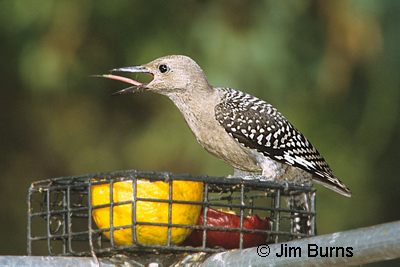
Here are three facts about woodpeckers even most hard-core birders don't know: they have the longest tongues in the bird world, up to 5 inches (!) in some species; they have folded facial bones and enlarged brain cases to absorb the shock of hammering into wood; and they probably cause more property damage than any other birds.
Every birder has a favorite family of birds, often based on beauty of plumage, quality of song, or proficiency of flight. My personal favorites run to families with special habitat niches and unusual physical adaptations which allow them to survive and thrive in those niches. Owls head my short list but the woodpecker family is close behind, nearly as remarkable as the owls for the number and diversity of its special evolutionary features.
Woodpeckers are evolved to live on arboreal boring insects: bills are chisel-shaped, long, strong, and straight to facilitate boring into trees and exploring the interstices in the bark; tongues are extremely long, barbed, and sticky, remarkably extensible because they are attached to two strips of cartilage which wrap entirely around the skull and anchor into the nostril or eye sockets; tail feathers are stiff and barbed to help support climbing and vertical posture; feet are zygodactyl (two toes forward, two backward) to help propel the bird upward along the tree bole.
If the extensive logging of our vast southeastern forests did, in fact, doom the ivory-bill to dust and dreams, there are still 22 woodpecker species in the U.S. Fifteen have been recorded in Arizona, and 3 of these, the Gila, the ladder-backed, and the gilded flicker live year round in Phoenix. If you're lucky you might observe all three in a morning at Papago Park or in the mesquite bosques along the Salt & Verde Rivers.
If you're unlucky, one of them may be driving you crazy excavating unsightly and irreparable holes in the eaves of your house. I know because I have had several inquiries about this from homeowners. Cornell University has a cool website covering all aspects of woodpecker damage, prevention, and control. Check out www.birds.cornell.edu/wp_about/. Email me and let me know what worked for you so I can share with other readers.
For those who have woodpeckers in their neighborhood and would like to see them up close and personal, try putting out halved oranges or apples or a suet cake. It's a great way to observe the unique physical features of an exquisitely adapted family of birds. And, if you see an ivory-billed in your backyard, don't email me. Call your eye doctor. I'm on the skeptical side of that fence.